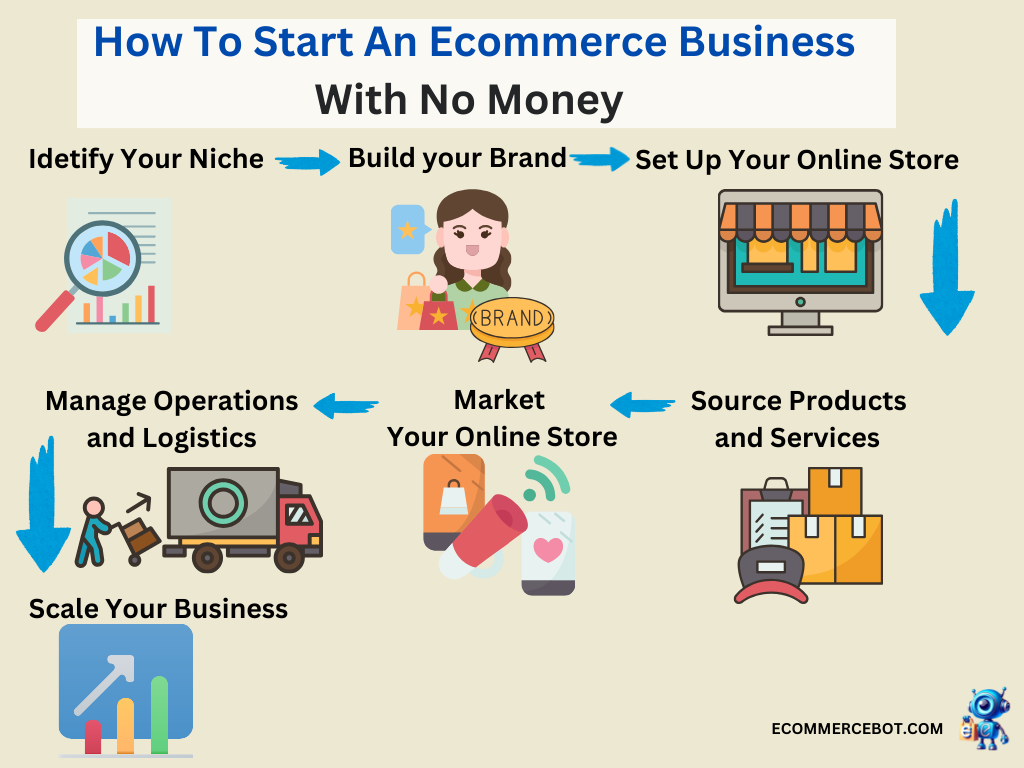The eCommerce industry is vast, bustling, and ever-expanding. In 2024, retail eCommerce sales are estimated to exceed 6.3 trillion U.S. dollars worldwide, showcasing this sector’s immense potential and opportunities.
Nowadays, starting an eCommerce business isn’t just an option; it’s a necessity for many aspiring entrepreneurs. The importance of venturing into eCommerce cannot be overstated.
It’s not just about making money; it’s about transforming lives. An eCommerce business can reach customers globally and provide financial freedom, flexibility, and the opportunity to pursue passions.
That’s where this guide comes in. Its purpose is to serve as a roadmap for those starting their eCommerce venture.
Whether you’re a seasoned entrepreneur looking to expand into the online realm or someone with a dream and determination, this guide will provide the essential knowledge and steps to kickstart your eCommerce journey.
Table of Contents
Understanding eCommerce
The landscape of eCommerce is diverse and dynamic, with various types of businesses finding success over the years.
From small independent sellers to multinational corporations, eCommerce has proven to be a versatile platform for commerce.
In this section, we’ll delve into the different facets of eCommerce, starting with the various models it encompasses.
We’ll explore:
- Business-to-business (B2B),
- Business-to-consumer (B2C), and
- Consumer-to-consumer (C2C) models,
Understanding what they are, how they function, who they cater to, and the industries they serve.
Types of eCommerce Models
There are three types of eCommerce businesses that you can pursue. Each eCommerce model presents its opportunities and challenges, and understanding the distinctions between them is essential for entrepreneurs looking to enter the online business space.

B2B (Business-to-Business) eCommerce
B2B eCommerce revolves around transactions between businesses. In this model, companies buy and sell goods or services to and from each other.
It’s prevalent across various industries, including manufacturing, wholesale, and distribution.
B2B transactions often involve bulk purchases and long-term contracts, aiming to fulfill the needs of businesses rather than individual consumers.
For instance, a manufacturer might sell raw materials or components to a wholesaler, who distributes the products to retailers.
B2B eCommerce platforms and systems are designed to streamline supply chain processes, facilitate efficient communication between trading partners, and automate transactions.
B2C (Business-to-Consumer) eCommerce
B2C eCommerce refers to transactions between businesses and individual consumers.
Many people are most familiar with this model, as it involves retail sales directly to end-users through online platforms.
In the B2C model, businesses cater to the needs and preferences of individual shoppers, offering a wide range of products or services across various industries.
For example, online clothing stores, electronics retailers, and food delivery services are all examples of B2C eCommerce businesses.
These businesses often focus on creating engaging user experiences, personalized marketing strategies, and seamless checkout processes to enhance customer satisfaction and drive sales.
C2C (Consumer-to-Consumer) eCommerce
C2C eCommerce facilitates transactions between individual consumers, enabling them to buy and sell products or services directly to one another through online marketplaces or platforms.
Unlike traditional retail models where businesses act as intermediaries, C2C platforms empower individuals to become sellers, fostering peer-to-peer transactions.
Examples of C2C platforms include online auction sites, classified ad websites, and peer-to-peer lending platforms.
C2C eCommerce relies heavily on user-generated content, customer reviews, and reputation systems to establish user trust and credibility.
It allows individuals to declutter their homes, earn extra income, or find unique items that may not be available through traditional retail channels.
Market Trends and Statistics
The rise of eCommerce isn’t a phenomenon that occurred overnight; instead, it’s the culmination of several factors that have transformed how we shop and conduct business in the digital age. From technological advancements to shifting consumer behaviors, various forces have propelled eCommerce to the forefront of global commerce.
The Rise of Mobile Commerce
Mobile commerce, or m-commerce, has witnessed a significant surge in recent years, driven by the widespread adoption of smartphones and tablets. Smartphones now account for nearly 80 percent of all retail website visits worldwide.
This trend underscores consumers’ increasing reliance on mobile devices for browsing products, comparing prices, and making purchases.
As mobile technology advances, businesses invest heavily in optimizing their websites and shopping experiences for mobile users, ensuring seamless navigation, fast loading times, and intuitive interfaces. Additionally, the rise of mobile payment solutions and digital wallets has further facilitated the growth of mobile commerce, offering consumers convenient and secure ways to complete transactions on the go.
The dominance of Certain Verticals in B2C eCommerce
Within business-to-consumer (B2C) eCommerce, specific verticals have emerged as dominant players, contributing significantly to online retail sales. Fashion and consumer electronics are among the top-performing sectors in B2C eCommerce, capturing a substantial share of consumer spending.

The appeal of fashion eCommerce lies in its ability to offer a diverse range of clothing, accessories, and footwear to fashion-conscious consumers, often accompanied by compelling visuals, personalized recommendations, and seamless shopping experiences.
Similarly, consumer electronics eCommerce thrives on the constant demand for the latest gadgets, devices, and technology-driven products.
From smartphones and laptops to smart home devices and wearables, consumers flock to online retailers to stay ahead of the curve and satisfy their tech cravings.
By tapping into these lucrative verticals, eCommerce businesses can capitalize on evolving consumer preferences and drive sustained growth in online retail sales.
The Prevalence of Online Marketplaces
Online marketplaces have emerged as the cornerstone of eCommerce, holding the largest share of online purchases globally as of 2023.
These digital platforms connect buyers and sellers worldwide and offer various products, services, and solutions across diverse categories and industries.
From household goods and electronics to fashion, beauty, and beyond, online marketplaces offer consumers unparalleled choice, convenience, and competitive pricing.
Market leaders such as Amazon, Alibaba, eBay, and Etsy have revolutionized how people shop and sell online, leveraging advanced technologies, robust logistics networks, and data-driven insights to create seamless marketplace experiences.
For sellers, online marketplaces offer unparalleled reach and exposure, allowing them to access a global customer base without requiring extensive marketing efforts or infrastructure investments.
By embracing the power of online marketplaces, eCommerce businesses can tap into new revenue streams, expand their customer reach, and thrive in today’s competitive digital landscape.
Advantages and Challenges of eCommerce
Just like any other business venture, eCommerce comes with its own set of advantages and challenges.
While the allure of online entrepreneurship may be enticing, it’s essential to understand the pros and cons associated with running an eCommerce business.
From the potential for global reach and scalability to the complexities of logistics and competition, eCommerce entrepreneurs must navigate a dynamic landscape to succeed.
Advantages of eCommerce
Global Reach and Accessibility
eCommerce breaks down geographical barriers, enabling businesses to reach customers beyond local markets.
With an online presence, companies can tap into a vast and diverse customer base worldwide, expanding their reach and potential for growth.
This global accessibility allows businesses to capitalize on emerging markets, target niche audiences, and increase brand visibility worldwide.
Lower Overhead Costs
Compared to traditional brick-and-mortar stores, eCommerce businesses typically have lower overhead costs.
ECommerce entrepreneurs can save on expenses and allocate resources more efficiently without needing physical storefronts, rental fees, or extensive inventory storage.
Additionally, digital marketing channels offer cost-effective ways to promote products and engage with customers, reducing marketing expenses compared to traditional advertising methods.
Flexibility and Convenience
eCommerce offers unparalleled flexibility and convenience for both buyers and sellers.
Customers can browse and shop at their convenience, anytime and anywhere, without the constraints of store hours or location.
Similarly, eCommerce businesses have the flexibility to operate 24/7, catering to customers’ needs around the clock.
This convenience enhances the shopping experience, fostering customer loyalty and repeat purchases.
Challenges of eCommerce
Intense Competition
The eCommerce landscape is highly competitive, with countless businesses vying for consumers’ attention.
Saturated markets and niche competition can make it challenging for new eCommerce ventures to stand out and attract customers.
To succeed in such a competitive environment, businesses must differentiate themselves through unique value propositions, exceptional customer service, and strategic marketing initiatives.
Security and Privacy Concerns
Security and privacy are paramount in eCommerce, given the sensitive nature of online transactions and personal data. Cybersecurity threats, such as data breaches, identity theft, and payment fraud, pose significant risks to businesses and consumers.
Building trust and credibility with customers requires implementing robust security measures, encrypting sensitive information, and adhering to strict compliance standards, such as PCI DSS (Payment Card Industry Data Security Standard).
Logistics and Fulfillment Complexities
eCommerce logistics and fulfillment present logistical challenges, particularly for small businesses entering the market.
Managing inventory, processing orders, and coordinating shipping and delivery require efficient systems and processes.
Additionally, navigating the complexities of international shipping, customs regulations, and supply chain disruptions can further complicate fulfillment operations.
Partnering with reliable logistics providers, investing in inventory management software, and optimizing order fulfillment workflows are essential steps to streamline operations and ensure customer satisfaction.
How to Start an eCommerce Business
Starting an eCommerce business can be an exciting journey filled with opportunities for growth and success.
While there are standard steps to building an eCommerce business, it’s important to remember that success ultimately hinges on your strategy and approach.
In a rapidly evolving digital landscape, adaptability, creativity, and innovation are key factors that can set your eCommerce venture apart from the competition.
This section explores the essential steps in starting an eCommerce business, from identifying your niche and building your brand to setting up your online store, sourcing products or services, and implementing marketing strategies.
Each step is crucial in laying the foundation for a successful eCommerce business, but how you execute and tailor these steps to fit your unique vision and goals will ultimately determine your success.
Identifying Your Niche
Finding your niche is akin to discovering your place in a crowded marketplace. It’s not just about carving out a space for yourself; it’s about finding a unique corner where your passion meets demand and your expertise aligns with consumer needs.

Identifying your niche is crucial for the success of your eCommerce business, as it lays the foundation for your brand, products, and target audience.
Market research techniques
Market research is essential for identifying market trends, understanding consumer behavior, and making informed business decisions. Here are three widely followed market research techniques:
1. Surveys and Questionnaires
Surveys and questionnaires are valuable tools for gathering data directly from your target audience.
They allow you to collect quantitative and qualitative information about consumer preferences, opinions, and purchasing behavior.
Surveys can be conducted through various channels, such as email, social media, or your website. Here’s how to conduct surveys effectively:
- Define your research objectives and formulate straightforward, concise survey questions.
- Select your target audience and determine the most appropriate survey distribution method.
- Design an engaging and user-friendly survey format to encourage participation.
- Analyze survey responses to identify trends, patterns, and insights that can inform your business decisions.
Surveys provide direct feedback from your target audience, allowing you to gain valuable insights into their needs, preferences, and expectations.
Analyzing survey data can help you identify market gaps, refine your product offerings, and tailor your marketing strategies to meet customer demand better.
2. Competitor Analysis
Competitor analysis involves researching and evaluating your competitors’ strategies, products, and performance in the market.
Studying your competitors can get you valuable insights into market trends, customer preferences, and industry benchmarks. Here’s how you can do it:
- Identify your main competitors and analyze their strengths, weaknesses, opportunities, and threats (SWOT analysis).
- Evaluate your competitors’ product offerings, pricing strategies, marketing tactics, and customer engagement channels.
- Assess your competitors’ online presence, including their website, social media profiles, and customer reviews.
- Benchmark your business performance against your competitors to identify areas for improvement and competitive advantages.
Competitor analysis allows you to benchmark your business against industry leaders, identify market trends, and capitalize on competitive opportunities.
You can use competitor analysis tools like Nichescrapper to analyze existing ecommerce stores.

Understanding your competitors’ strategies and tactics helps differentiate your brand, refine your marketing approach, and stay ahead of the competition.
3. Keyword Research
Keyword research is vital to search engine optimization (SEO) and content marketing strategy.
By identifying the keywords and phrases your target audience is searching for online, you can optimize your website content, improve your search engine rankings, and attract relevant traffic. Here’s how to carry out efficient keyword research:
- Use keyword research tools such as Google Keyword Planner, SEMrush, or Ahrefs to identify relevant keywords and phrases related to your niche.
- Analyze keyword search volume, competition, and relevance to prioritize your target keywords.
- Identify long-tail keywords and niche-specific terms with lower competition but higher conversion potential.
- Incorporate target keywords into your website content, including product descriptions, blog posts, and meta tags.
Keyword research helps you understand your target audience’s language and search intent, allowing you to optimize your content and attract qualified leads to your website.
Targeting relevant keywords improves your visibility in search engine results pages (SERPs) and drives organic traffic to your eCommerce store.
Assessing demand and competition
Assessing demand and competition is crucial for the success of an eCommerce business, as it allows entrepreneurs to identify market opportunities, understand consumer needs, and differentiate their offerings from competitors.
Here are three practical ways to assess demand and competition in the eCommerce landscape:
1. Market Research and Analysis
Market research involves gathering and analyzing data on industry trends, consumer behavior, and competitor strategies.
Conducting thorough market research can help you discover insights into market demand, customer preferences, and competitive dynamics.
This information enables them to make informed decisions about product development, pricing strategies, and marketing initiatives.
Market research can be conducted through various methods, including surveys, competitor analysis, and industry reports. Here’s how to conduct market research effectively:
- Define your research objectives and target audience.
- Identify key industry trends, market segments, and customer demographics.
- Analyze competitor offerings, pricing strategies, and customer reviews.
- Gather data from primary and secondary sources, such as surveys, interviews, and industry publications.
- Use market research tools and analytics platforms to analyze data and extract actionable insights.
Market research helps eCommerce entrepreneurs understand market demand, identify competitive threats, and uncover untapped opportunities.
Conducting thorough market research minimizes risks, optimizes product offerings, and develops targeted marketing strategies to attract and retain customers.
2. Customer Feedback and Engagement
Customer feedback and engagement provide valuable insights into customer preferences, satisfaction levels, and pain points.
Engaging with customers through surveys, reviews, and social media channels helps eCommerce entrepreneurs gather feedback on their products, services, and overall shopping experience.
This feedback enables entrepreneurs to identify areas for improvement, address customer concerns, and enhance customer satisfaction.
- Encourage customers to leave reviews and ratings on your products and services.
- Monitor social media channels, forums, and review sites for customer feedback and mentions of your brand.
- Send surveys and questionnaires to collect product quality, pricing, and customer service feedback.
- Analyze customer feedback and identify recurring themes, trends, and areas for improvement.
- Use customer feedback to make data-driven decisions about product development, pricing strategies, and marketing initiatives.
Customer feedback and engagement are essential because they help eCommerce entrepreneurs understand customer needs, preferences, and pain points.
Listening to customer feedback and addressing their concerns builds trust, loyalty, and long-term relationships with their customers.
Building Your Brand
Establishing a strong brand is crucial for the success and longevity of your eCommerce business. Your brand is the foundation of your identity, influencing how customers perceive and interact with your products or services.
In a competitive marketplace, having a well-defined and recognizable brand can set you apart from competitors, foster customer trust and loyalty, and ultimately drive sales and revenue.
Therefore, building your brand correctly ensures that every element – from your brand identity to your brand story – accurately reflects your values, resonates with your target audience, and leaves a lasting impression.
Defining your brand identity
Defining your brand identity is the foundation of building a solid and recognizable brand. Your brand identity encompasses your values, personality, and unique selling proposition (USP) that sets you apart from competitors. To define your brand identity:
- Identify your core values and mission statement: Determine what your brand stands for and the principles that guide your business.
- Understand your target audience: Define your ideal customer personas and tailor your brand identity to resonate with their needs and preferences.
- Establish your brand voice and tone: Determine the style and personality of your brand communication, whether casual and conversational or professional and authoritative.
- Conduct a competitive analysis: Analyze competitors’ branding strategies to identify gaps in the market and opportunities to differentiate your brand.
Creating a memorable brand name and logo
Your brand name and logo are the visual representations of your brand identity and play a crucial role in shaping consumer perceptions and recognition. To create a memorable brand name and logo:
- Brainstorm potential brand names: Generate a list of creative and relevant names that reflect your brand identity and resonate with your target audience.
- Conduct trademark research: Ensure that your chosen brand name is available for trademark registration and doesn’t infringe on existing trademarks.
- Design a distinctive logo: Hire a professional graphic designer or use online tools to create a visually appealing and memorable logo that embodies your brand identity.
- Test your brand name and logo: Gather feedback from focus groups or conduct surveys to gauge consumer perception and ensure your brand name and logo resonate with your target audience.
Crafting your brand story
Your brand story is the narrative that communicates your brand’s history, values, and mission compellingly and authentically. Crafting a compelling brand story can humanize your brand, foster emotional connections with customers, and differentiate your brand from competitors. To prepare your brand story:
- Define the key elements of your brand story: Determine the pivotal moments, values, and experiences that have shaped your brand’s journey.
- Identify your target audience: Tailor your brand story to resonate with your target audience’s needs, aspirations, and values.
- Communicate authenticity: Share genuine and transparent stories reflecting your brand’s experiences and values.
- Choose the proper storytelling channels: Use a combination of written content, visuals, videos, and social media platforms to share your brand story and engage with your audience.
Setting Up Your Online Store
Establishing an online store is the digital gateway to your eCommerce venture, representing your brand and enabling customers to access your products or services anywhere in the world. As the centerpiece of your online presence, your store must be meticulously set up to ensure seamless navigation, secure transactions, and an exceptional user experience.
Choosing the Right eCommerce Platform
Selecting the appropriate eCommerce platform is paramount as it forms the backbone of your online store’s functionality and performance.
- Assess your business needs: Determine your budget, technical expertise, scalability requirements, and desired features.
- Research available platforms: Explore different eCommerce platforms such as Shopify, WooCommerce, Magento, and BigCommerce, considering ease of use, customization options, and support.
- Compare features and pricing: Evaluate each platform’s features, pricing plans, and scalability options to find the best fit for your business.
- Consider future growth: Choose a platform to accommodate your long-term business goals and scale as your online store grows.

Selecting a Domain Name and Hosting Provider
Your domain name and hosting provider are integral to your online store’s infrastructure, influencing its visibility and accessibility.
- Choose a memorable domain name: Select a domain name that reflects your brand identity, is easy to spell, and resonates with your target audience.
- Check domain availability: Use domain registration services to check the availability of your desired domain name and register it if available.
- Select a reliable hosting provider: Choose a hosting provider that offers reliable uptime, fast loading speeds, scalable hosting plans, and excellent customer support.
- Consider security features: Opt for a hosting provider that prioritizes security measures such as SSL certificates, regular backups, and malware protection to safeguard your online store and customer data.
Designing a User-Friendly Website
The design of your online store plays a crucial role in shaping the user experience and influencing customer engagement and conversions.
- Choose a responsive design: Ensure your website is optimized for mobile devices and provides a seamless browsing experience across various screen sizes.
- Simplify navigation: Design an intuitive navigation structure that allows customers to easily find products, browse categories, and access important pages.
- Optimize product pages: Create visually appealing product pages with high-quality images, detailed descriptions, and clear calls to action to encourage conversions.
- Incorporate trust signals: Include trust badges, customer reviews, and secure payment icons to instill confidence and credibility in your online store.
Integrating Payment Gateways and Security Measures
Securing online transactions and protecting customer data are paramount for building trust and credibility with your audience.
- Choose reliable payment gateways: Integrate reputable payment gateways such as PayPal, Stripe, or Square to offer secure payment options to your customers.
- Implement SSL encryption: Install SSL certificates on your website to encrypt sensitive data and secure online transactions.
- Comply with PCI DSS standards: Ensure compliance with Payment Card Industry Data Security Standard (PCI DSS) requirements to protect customer payment information.
- Monitor for security threats: Regularly monitor your online store for security vulnerabilities, malware, and suspicious activities, and take proactive measures to address any issues.
Sourcing Products or Services
Sourcing the right products or services is critical to building a successful eCommerce business. Your choice of suppliers and the quality of your offerings directly impact customer satisfaction, brand reputation, and profitability.
Researching Suppliers and Manufacturers
Researching suppliers and manufacturers is the first step in sourcing products or services for your eCommerce business.
- Define your sourcing criteria: Determine your product requirements, including quality standards, price range, and shipping options.
- Explore sourcing options: Research potential suppliers and manufacturers through online directories, trade shows, industry forums, and networking events.
- Verify supplier credentials: Verify the credibility and reliability of potential suppliers by checking their reputation, customer reviews, certifications, and years of experience in the industry.
- Request samples and quotes: Request product samples and pricing quotes from multiple suppliers to compare quality, pricing, and terms.
Evaluating Product Quality and Pricing
Evaluating product quality and pricing is essential to offer competitive products or services that meet customer expectations.
- Conduct product testing: Test product samples to evaluate quality, functionality, durability, and adherence to specifications.
- Compare pricing and terms: Compare pricing, minimum order quantities, payment terms, and shipping costs from different suppliers to find the best value for your business.
- Consider the total cost of ownership: Evaluate the total cost of sourcing, including product costs, shipping fees, import duties, and taxes, to determine the actual cost of each product.
- Negotiate pricing and terms: Negotiate pricing, discounts, and terms with suppliers to secure favorable agreements that align with your business goals and budget.
Establishing Relationships with Suppliers
Establishing solid relationships with your suppliers ensures smooth operations, reliable product supply, and mutual trust.
- Communicate openly and transparently: Maintain open lines of communication with your suppliers, sharing your expectations, feedback, and concerns openly and honestly.
- Build trust and reliability: Demonstrate your commitment to reliability and professionalism by honoring agreements, paying invoices on time, and resolving any issues promptly.
- Collaborate on product development: Collaborate with suppliers on product development, customization, and improvements to create unique offerings that meet customer demand.
- Explore partnership opportunities: Explore partnership opportunities with key suppliers, such as exclusivity agreements or joint marketing initiatives, to strengthen your competitive advantage and drive mutual growth.
Marketing and Promotion
Marketing and promotion are pivotal in elevating brand awareness, directing traffic to your eCommerce store, and ultimately amplifying sales. Crafting an effective marketing strategy involves harnessing a blend of digital marketing techniques to engage your target audience.
Developing a Marketing Strategy
Establishing your objectives, determining your target market, developing a persuasive message, and choosing the proper methods for reaching out to possible clients are all necessary steps in creating a thorough marketing plan. You may focus your efforts on reaching company goals and optimizing returns on investment by creating a solid marketing plan.
Utilizing SEO Techniques to Improve Visibility
Search engine optimization improves your internet presence and adds inbound links to your e-commerce site. Putting SEO strategies like link building, content production, and keyword optimization into practice may improve your website’s search engine ranks and attract more quality leads.
Leveraging Social Media and Content Marketing
Social media and content marketing are powerful instruments for building brand loyalty, engaging audiences, and driving traffic to your online business. Engaging content that connects with your audience and disseminating it on social media helps you build customer relationships, promote social interactions, and increase brand awareness.
Utilizing Paid Advertising Options (PPC, Social Media Ads, etc.)
Paid advertising offers focused channels for connecting with prospective clients and delivering fast outcomes. While social media advertising offers precision targeting based on demographics, interests, and behaviors, pay-per-click (PPC) advertising lets you bid on keywords and display ads on search engines. Putting money into paid advertising increases exposure, generates leads, and sparks conversions for your online store.
Managing Operations and Logistics
The foundation of any eCommerce company is operations and logistics management, which guarantees smooth workflows for everything from order fulfillment and customer support to inventory control.
Maximizing these factors may improve productivity, client happiness, and general business success.
Inventory Management Systems
Robust inventory management systems must be implemented to minimize excess inventory, avoid stockouts, and maintain ideal stock levels.
You can automate reorder procedures, monitor inventory levels in real-time, and learn more about inventory turnover rates using inventory management software.
It helps you to optimize inventory investments, streamline processes, and make data-driven choices.
Order Fulfillment and Shipping Processes
For orders to be delivered to clients precisely and on time, efficient order fulfillment and shipping procedures are essential. Order processing, order picking, and delivery may all be guaranteed on time with the help of efficient workflows and dependable shipping carriers. This lowers transportation costs, increases customer happiness, and encourages recurring business.
Customer Service and Support
Building trust, loyalty, and a favorable brand reputation requires outstanding customer service and assistance.
By providing a variety of avenues for customer contact, including phone, email, and live chat, you can respond to questions from clients, handle problems quickly, and give individualized service.
You may consistently raise the caliber of your services and improve client experiences by funding customer service training and implementing customer feedback systems.
Scaling Your Business
Scaling your business is an exciting yet challenging phase that involves expanding operations, increasing revenue, and accommodating growth opportunities. To scale your eCommerce venture sustainably, you must analyze potential growth avenues, develop product lines or services, consider staffing needs, and implement efficient systems and processes.
Analyzing Growth Opportunities
Analyzing growth opportunities entails assessing market trends, customer demands, and competitive landscapes to identify areas for expansion.
Conducting thorough market research and analyzing customer feedback uncovers new markets, niches, or product categories ripe for growth.
It allows you to capitalize on emerging trends, penetrate new markets, and diversify revenue streams.
Expanding Product Lines or Services
Expanding your product lines or services enables you to cater to a broader audience and increase customer lifetime value. Diversifying your offerings or introducing complementary products helps cross-sell and upsell existing customers while attracting new ones. It expands your market reach and enhances brand loyalty and revenue potential.
Hiring Employees or Outsourcing Tasks
As your business grows, you may need to augment your workforce to meet increasing demands and maintain operational efficiency. Hiring employees or outsourcing tasks allows you to delegate responsibilities, streamline workflows, and focus on core business activities. Whether hiring full-time staff or engaging freelancers or agencies, investing in talent ensures scalability and enables you to scale operations effectively.
Implementing Efficient Systems and Processes
Implementing efficient systems and processes is crucial for managing growth and maintaining consistency across your operations.
Automating repetitive tasks, streamlining workflows, and optimizing operational efficiencies reduce costs, minimize errors, and enhance productivity.
Leveraging technology solutions such as AI integration, inventory management software, CRM systems, and project management tools empowers you to scale your business operations seamlessly.
Conclusion
Now armed with a comprehensive guide on how to start an eCommerce business, it’s time to take action. Following the steps outlined in this guide, you’re equipped with the knowledge and strategies to launch your eCommerce venture effectively.
Remember to continuously analyze growth opportunities, expand your product lines or services, and implement efficient systems and processes to scale your business successfully.
However, embarking on an eCommerce journey has its challenges. Be mindful of pitfalls such as intense competition, security concerns, and logistical complexities.

Stay vigilant and adapt quickly to changes in the market landscape to stay ahead of the curve.
But don’t let these challenges deter you. With determination and perseverance, you can overcome obstacles and achieve success in the world of eCommerce.
To make your journey even smoother, consider trying out EcommerceBot.com. It offers a fully automated eCommerce solution ideal for beginners, helping you maximize profits and streamline operations effortlessly.

